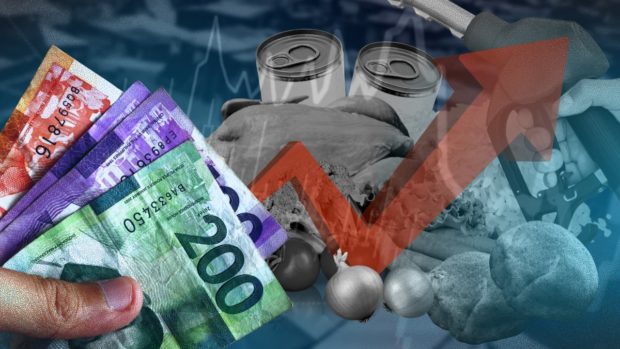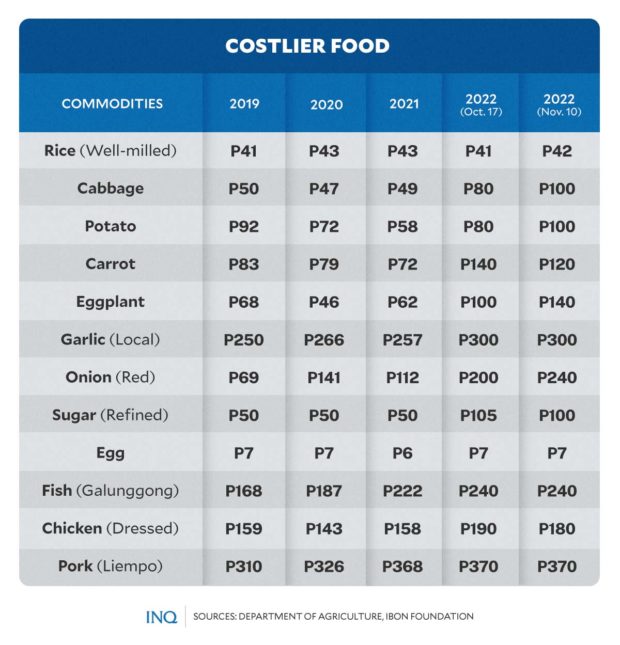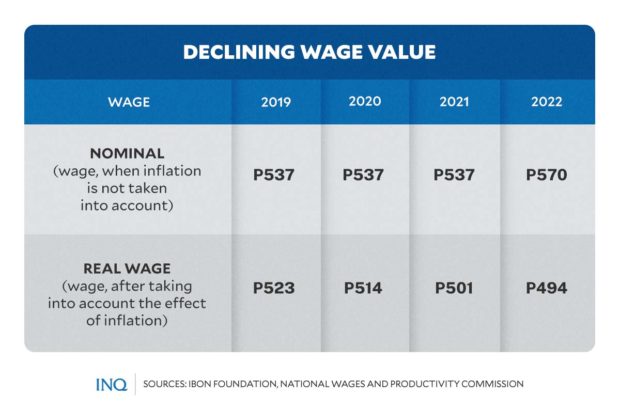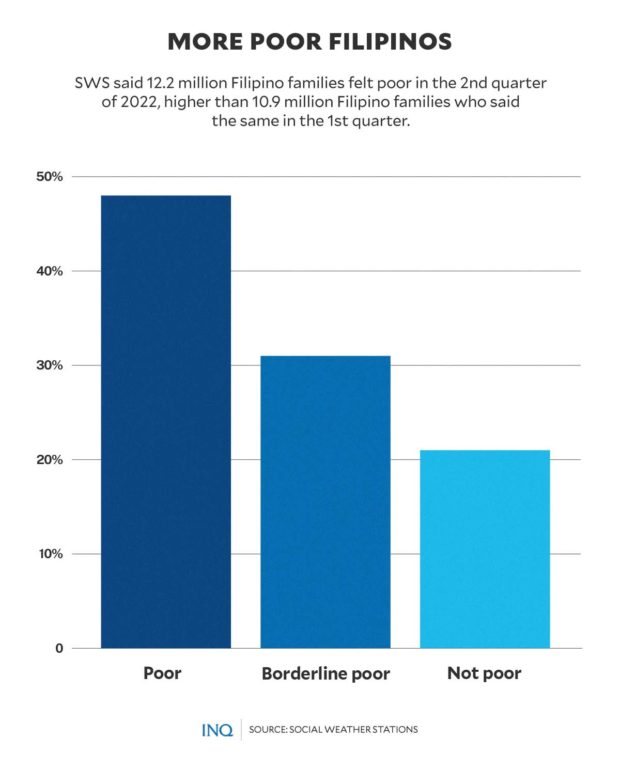Pesky inflation: What individuals, gov’t can do as high prices threaten economy
MANILA, Philippines—As Filipinos struggle with rising inflation that hit an almost 14-year high last month, a suggestion to cope with the steep price hikes went viral on Facebook—the five-second rule for food that has fallen on the ground is now 10 seconds.
The post, which was made by Bisaya District on Wednesday (Nov. 9), already received 42,000 reactions, 1,100 comments and 32,000 shares, with some even suggesting ways to keep dropped food “safe to eat.”
But of course, it was a wisecrack as healthline.com explained that the rule is not safe at all, stressing what Rutgers University researchers said: Moisture, the type of surface, and contact time on the ground all contribute to cross-contamination.
It stressed that while certain types of food fare better than the rest when dropped on the ground, there are instances where the transfer of bacteria can begin in less than one second.
“If you’re ever in doubt about what to do, most experts agree that the safest thing is to err on the side of caution. If you’re not sure whether it’s safe to eat something that’s fallen on the ground, throw it out.”
Article continues after this advertisementBut reverting to the issue of inflation, which is a problem confronted by Filipinos every day, especially now that the readout hit 7.7 percent, here are some ways to cope with relentless price hikes:
Article continues after this advertisement- Lessen your expenses
As stressed by DBS Financial Planning, have time to review your expenses regularly to make necessary changes, like splitting expenses into fixed and discretionary spends.
It said fixed expenses include utility bills, loans, and rents, while discretionary expenses are usually “good-to-haves” such as entertainment, gym subscriptions, and even internet and call or text subscriptions.
- Plan meals
Consumer finance expert Andrea Woroch told the Next Advisor and TIME Magazine that when it comes to staples, one can save money by being more efficient with what he or she buys.
One way to do this is planning meals to get better at shopping staples: “Look at your calendar and plan for the nights you’ll be home and the days you or the kids will need to bring lunch to work or school. Find recipes that use the same ingredients.”
- Look for side jobs
Likewise, finding ways to earn extra income can help relieve some of the pressure from the increased cost of living. “If asking for a pay raise is not quite possible, you can explore various sources of side income.”
“Some examples include tutoring, using your car for private hires, selling items that you no longer use or making some money out of a hobby like baking,” DBS Financial Planning said.
Filipinos really struggling
But since not all Filipinos do not have the luxury to cope with inflation, the think tank Ibon Foundation said the government has to act now by giving enough ayuda for the poorest families.
This, as it stressed that “substantial ayuda will also improve household welfare, spur economic activity, and help give the supply-side measures [in tempering inflation] more traction.”
But why are all these needed?
As the Philippine Statistics Authority (PSA) said, the readout, which was higher than 6.9 percent in September, accelerated because of a higher annual growth rate in the price index for food and non-alcoholic beverages, which rose to 9.4 percent from 7.4 percent.
Higher annual increments in alcoholic beverages and tobacco (10.4 percent), housing, water, electricity, gas (7.4 percent), and restaurants and accommodation services (5.7 percent) also contributed to the acceleration of inflation.
READ: Philippines inflation near 14-year high; more rate hikes seen
Even on Twitter, the post about the five-second rule, having received 37,100 likes and 9,960 retweets, also went viral, with one even saying that “we will not die of sickness but of how expensive basic needs are.”
hindi tayo sa sakit matetegi, sa mahal ng bilihin kaya lavan https://t.co/orFa4ffirT
— li. (@yuriidice) November 10, 2022
The latest readout also came near the top end of the Bangko Sentral ng Pilipinas’ 7.1 percent to 7.9 percent inflation forecast for October. Year to date, average inflation stood at 5.4 percent.
Based on data from the PSA, core inflation, which excludes selected food and energy items in the headline inflation, rose to 5.9 percent in October 2022, from 5 percent in September. In October 2021, core inflation stood at just 2.5 percent.
Hit hardest
As stressed by the Brookings Institution, high inflation “tends to worsen inequality or poverty because it hits income and savings harder for poorer or middle-income households than for wealthy households.”
What’s worse, it said, is that “households that have recently escaped poverty could be pushed back into it by rising inflation,” the think tank, which is based in the United States (US), said.
Last August, the polling firm Social Weather Stations (SWS) revealed that 12.2 million Filipino families felt poor in the second quarter of 2022, higher than 10.9 million in the first quarter of this year.
The survey, which was conducted from June 26 to 29, found that 48 percent of families felt “poor,” while 31 percent categorized themselves as “borderline poor.”
READ: 12.2M Filipino families felt ‘poor’ in Q2 of 2022 — SWS survey
Only 21 percent considered themselves “not poor.”
Ibon Foundation previously stressed that joblessness and falling incomes had increased the number of families without savings since the start of the year—increasing by a million to reach 19.4 million as of the third quarter.
It told INQUIRER.net that “accelerating inflation means even less consumption for these millions of families who do not have any buffers to compensate for any rise in prices of basic goods and services.”
Real wages falling
As a result of the steep price hikes, Ibon said the nominal wage in Metro Manila, which is P570, “is now worth much less and unable to buy the same amount of basic needs such as food as before.”
Because of this, real wages, which is the pay a person can expect to receive once inflation is taken into account, are falling: “Calls for wage increase and cash aid are more than ever justified.”
This, as Ibon previously explained that when inflation drives the real value of wages to all-time lows, basic food and transportation services are expected to be almost out of reach, especially for the poor.
Based on data from the Department of Agriculture, well-milled rice is worth P42 a kilo, higher than P41 in 2019, while native garlic and red onion now cost P300 and P240 a kilo, higher than P250 and P69 a kilo in 2019.
A kilo of eggplant is now P140, more expensive compared to just P68 in 2019. Cabbage, potato, and carrot are now worth P100, and P120 a kilo, while refined sugar and egg now cost P100 and P7.
The price of galunggong likewise spiked to P240 from P168 a kilo in 2019, while dressed chicken and pork liempo are now worth P189 and P354 a kilo, Ibon Foundation said.
Wages to be reviewed
Because of the steep price hikes, the Department of Labor and Employment said in a television report on Tuesday (Nov. 8) that it has ordered the regional wage boards to review the possibility of a wage increase for four million minimum wage earners.
“This (wage hike) is something we are studying. We are not disregarding recent events. That’s why our Regional Tripartite Wages and Productivity Boards have the directive that even though we just recently issued wage adjustments, we will still consider the current situation so we can help our workers and entrepreneurs.”
READ: Citing steep price hikes, DOLE orders wage review
As stressed by the PSA last Nov. 4, it sees a “substantial probability” that inflation could increase further in November, partly because of the impact of a recent destructive tropical storm, Paeng.
GlobalSource, a New York-based think tank, said inflation will likely remain elevated for longer than expected, as upward price pressures in the global food market remain, dragging on the recovery of domestic supplies ravaged by a recent series of typhoons.
“[This] inflation surprise, alongside more recent damages to agricultural output due to typhoons, as well as net upside risks from global and local factors, can be expected to further feed into inflation expectations.”
Based on data from Ibon, inflation pushed the living wage, or the amount needed by a family of five to live decently, in Metro Manila to P1,133 a day from P1,119 in September.
Addressing inflation
The BSP had said it will hike its key interest rates by 75 basis points at its Nov. 17 policy meeting to match the latest monetary tightening by the US Federal Reserve.
The Philippine central bank intended to maintain the interest rate differential prevailing before the most recent US Fed rate hike, in order to temper any impact on the country’s exchange rate.
But Ibon stressed that raising key interest rates can be “double-edged” and is a “mechanical, conventional and inappropriate approach to current conditions.”
It recalled that key interest rates have so far been raised five times this year starting in July when inflation reached 6.1 percent in June.
“Raising interest rates may reduce aggregate demand and inflationary pressures but can also dampen economic activity, depress jobs and reduce household incomes further,” it said.
“But the economy has been slowing, so-called job creation is mostly low-paying and informal, and household incomes are already suppressed. Choking the economy and livelihoods is the wrong price to pay to lessen inflation.”
It explained that while interest rate hikes may also seek to temper the depreciation of the peso, the government should instead consider more direct measures to reduce the demand for foreign exchange.
“One is spending less on import-dependent infrastructure projects and on external debt service. Another is possibly coordinating with other Southeast Asian countries and increasing controls on the outflow of foreign capital such as with transaction taxes, volume restrictions, and other regulations,” it said.
Beyond raising interest rates
Ibon stressed that there are still some ways by which inflation can be tempered beyond raising interest rates, saying that the government can address high inflation and help millions of Filipinos cope with rising prices if it wanted to.
When it comes to the supply side, it said prices can be immediately lowered by suspending or removing consumption taxes such as value-added tax and oil excise. Revenue losses from this may partially be offset by increased economic activity.
It added that revenue losses from scrapping consumption taxes can even be more directly addressed with higher taxes on high-income families, large corporations and billionaire wealth.
Likewise, considering that most of the inflation is from food, it said the government can also help lower prices with increased production, marketing and logistics support for rural producers.
When it comes to the demand side, “wage hikes can be a start to support the purchasing power of families which has eroded so much after the excessive pandemic lockdowns and incessant oil and other price hikes.”
“Large and medium firms are likely to afford this, said the group, while small and micro enterprises can be assisted by the government with wage subsidies,” it said.
The government, Ibon said, “needs to give much more attention to addressing chronic vulnerabilities rooted in underdeveloped agriculture and domestic industry rather than being trapped in old ways of thinking and not doing everything to relieve the Filipino people’s mounting distress.”
Economist and Albay Rep. Joey Salceda had expressed confidence that the Philippines can sustain its recent 7.6 gross domestic product growth, especially given the government’s “shift from pandemic to endemic mode for COVID-19.”
READ: Philippine Q3 GDP growth ‘much better than consensus forecast’ -Finance Minister
However, he said “moving forward, the biggest threat to sustaining growth next year is still inflation…it will still be food, feed, and fuel.”





